Sapphire Cards or The Tale of Six Radeon-s
Sapphire CompanyIt has been represented in Russia for several years and is one of the largest suppliers of AMD video cards in Russia. The company has earned itself a good name in the Russian market, primarily with the quality of its products, attractive prices, and the good overclocking potential of its products, which is very important for computer enthusiasts. Sapphire was again ahead of other vendors with the release of AMD fifth-series graphics cards. It is necessary to say a few words to readers about the innovations in this series, which are plentiful. The main feature of products positioned as “evergreens” is DirectX11. Without exception, all cards support the eleventh DirectX and allow you to enjoy chic effects. Why are you evergreens, you ask? From now on, AMD decided to abandon the lettering in the name of its graphic cores. The names for the new GPUs are Cypress - cypress, Hemlock - Tsuga, Juniper - Juniper, Cedar - Cedar, Redwood - Mahogany. All GPUs have performance differences, but support a common set of technologies. DirectX11 is based on tessellation - the process of splitting an image into smaller shapes, such as triangles or quadrangles. This is because the detail in games is increasing, so the need for better textures is growing all the time.
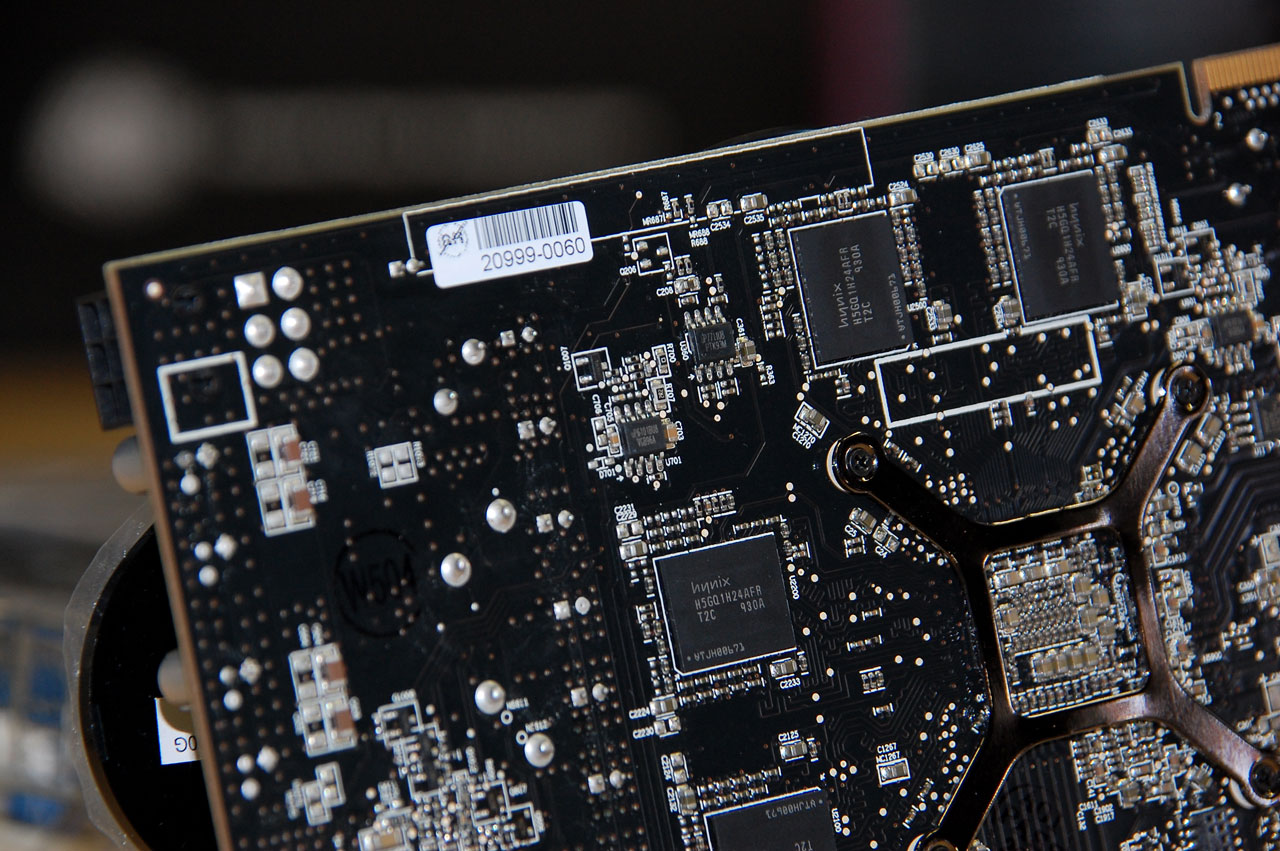

Since Sapphire products were the first to appear on the Russian market, we selected products of this brand for testing the line of video cards of the fifth series from AMD.
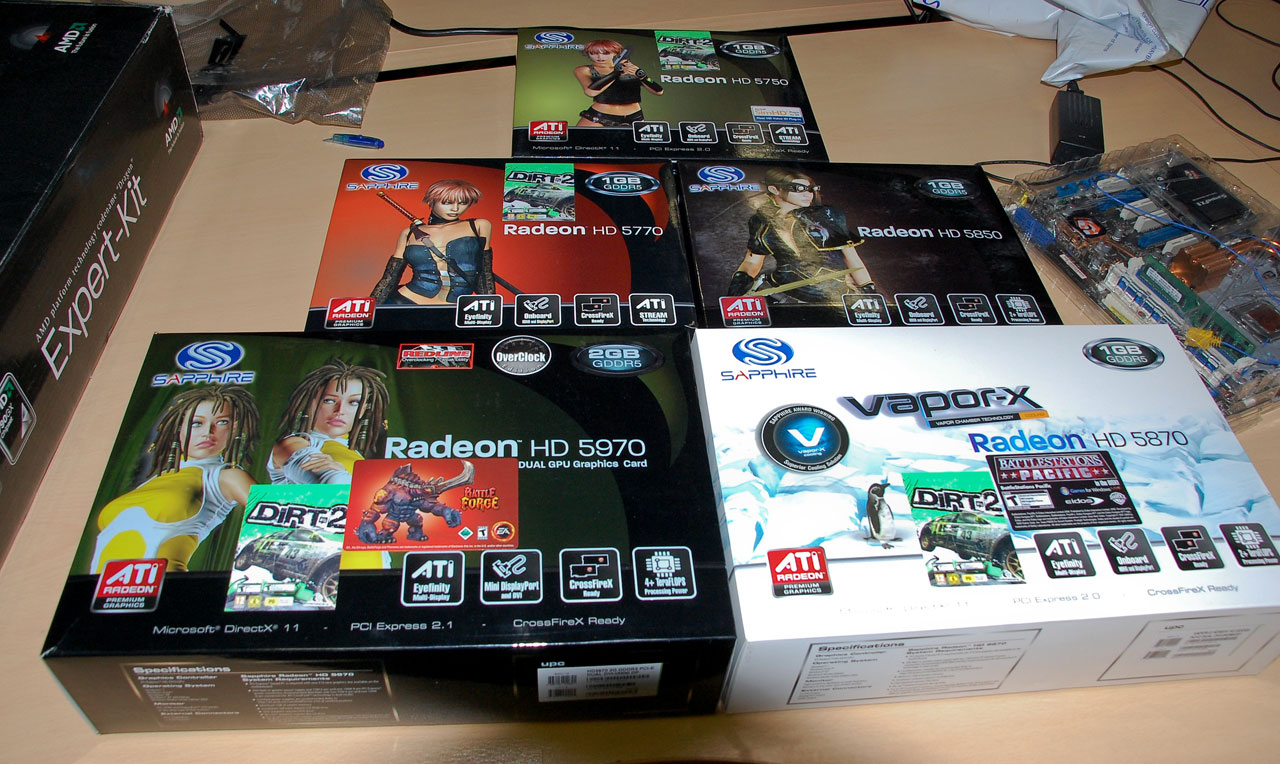
What and how did we test?
We selected a pair of video cards for each model from the Sapphire HD5xxx family and compared them to each other in 3D benchmarks and games. CrossFire configurations also took part in testing. All video cards were tested at nominal frequencies, and we, OCClub.ru , as a project focused on overclocking, checked the video cards for maximum overclocking.
The list of tested video cards:
* 2x Sapphire HD 5970 (735/1010 MHz)
* 2x Sapphire HD 5870 (850/1200 MHz)
* 2x Sapphire HD 5850 (725/1000 MHz)
* 2x Sapphire HD 5770 (850/1200 MHz)
* 2x Sapphire HD 5750 (700/1150 MHz) The
data of the video card, both in single mode and in CrossFire passed the following tests:
* 3DMark06 - a popular graphics benchmark from Futuremark 2006, showing to this day excellent graphics performance. Default settings.
* 3DMark Vantage - the latest graphics benchmark, originally sharpened for Nvidia. But with the release of HD5xxx, everything has changed. Default settings.
* Heaven - the first DirectX11 benchmark with impressive graphics. Surely, this test will become mandatory in the future set of testers.
* Crysis Warhead - a game that has conquered millions of people around the world. Settings: resolution 1920x1200, graphics quality Very High.
* FarCry2 - a game on the Cry Engine engine with beautiful graphics and an exciting plot. Settings: 1920x1200 resolution, Ultra High quality graphics.
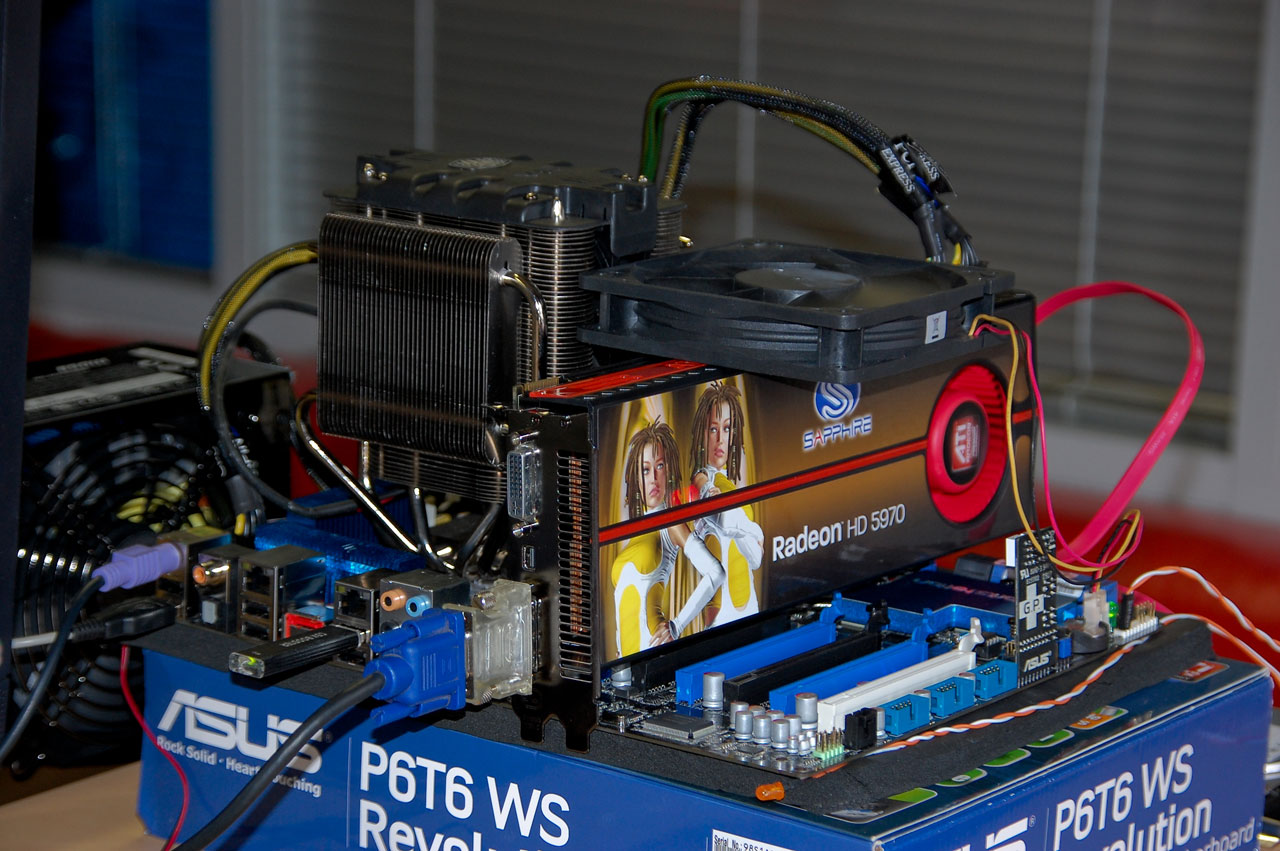
Test bench:
* Intel Core i7 Extreme 975 3.33 GHz @ 4 GHz processor
* Cooler Master V8 cooler
* Asus P6T6WS Revolution motherboard
* 3x 2Gb Kingston 2000 MHz DDR3 CL9 RAM
* Seagate Barracuda 7200.12 500 GB hard drive
* Cooler power supply Master MPower 850W
Sapphire Radeon HD5970 (27,000 rubles)
Test score: 9/10
* number of stream processors - 3200
* number of texture units - 2x 80
* number of ROP blocks - 2x 32
* core frequency - 735 MHz
* memory frequency - 1010 MHz
* memory bus width - 256 bits
* memory capacity - 2x 1024 MB
* TDP level - 294 W

AMD’s top-end two-headed product turned out to be so powerful that the gap in performance from previous-generation video cards turned out to be significantly higher. Honestly, no one expected this level of performance. Hemlock is a dual Cypress, but due to the presence of two cores on the same PCB, the core frequencies are reduced to 725 MHz instead of 850 MHz. Also, with the aim of falling within a certain TDP framework, voltages are also less than usual for Cypress 1.16v. Nevertheless, the fervor of the HD5970 is very hot. Cards from Sapphire were able to overclock to frequencies of 950/1200 MHz, which is a very high indicator. The disadvantages of this card include the high retail price - 27,000 rubles. A bunch of a pair of such video cards can become a utopia in the dreams of avid gamers.
Sapphire Radeon HD5870 (16 000 rubles)
Assessment by test results: 8/10
* number of stream processors - 1600
* number of texture units - 80
* number of ROP blocks - 32
* core frequency - 850 MHz
* memory frequency - 1200 MHz
* memory bus capacity - 256 bits
* memory capacity - 1024 MB
* TDP level - 188 W

The single-chip version of the top class appeared several months earlier on the shelves of Russian stores. Reviews of the card, released on the day of the official announcement, were full of positive moments. The overclocking potential of this card is even better than that of the dual-chip fellow flagship. This is easily explained by the lower temperatures inside the video card itself. Our copies were able to work stably at frequencies of 1000/1200 MHz. The main difference from lower class cards is the presence of a 256 bit memory bus, which allows for higher memory bandwidth. A pair of such monitors bypasses their older "two-headed brother" because of the high core / memory frequencies. But here the total cost against the Radeon HD 5970 will turn out more.
Sapphire Radeon HD5850 (12 500 rubles)
Based on test results: 8/10
* number of stream processors - 1440
* number of texture blocks - 72
* number of ROP blocks - 32
* core frequency - 725 MHz
* memory frequency - 1000 MHz
* memory bus capacity - 256 bits
* memory capacity - 1024 MB
* TDP level - 151 W
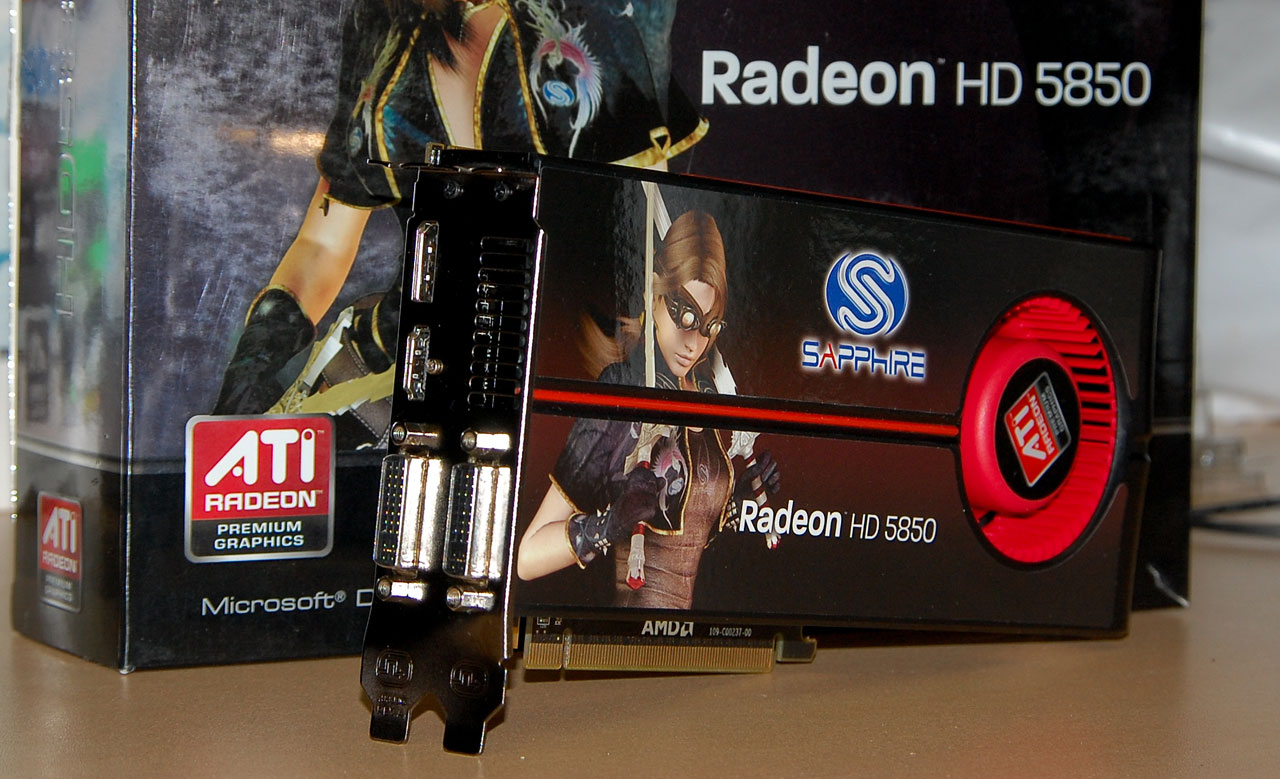
The same Cypress, but with low frequencies and high overclocking potential. Cheaper, colder, quieter is a lot of positive moments. Where are the minuses you ask? You won’t believe it, but I didn’t find any cons, the cards easily overcame the nominal level of HD5870 in overclocking and settled at 920/1150 MHz. And this is without raising the voltage on the GPU! There is also good news for those who have a case not the latest model. The video card can be installed in most modern cases without problems, when the HD5870 and HD5970 can have problems installing them in the case. One card is the best purchase, and a pair is doubly the best choice.
Sapphire Radeon HD5770 (6,500 rubles)
Based on test results: 7/10
* number of stream processors - 800
* number of texture units - 40
* number of ROP blocks - 16
* core frequency - 850 MHz
* memory frequency - 1200 MHz
* memory bus width - 128 bits
* memory capacity - 1024 MB
* TDP level - 108 W

Juniper is a graphics core whose main difference from its older counterparts is the presence of only a 128 bit memory bus. For a graphic memory of 1024 MB, about a year ago, a 128 bit memory bus was not enough. Of course, I understand that this is a low-end graphics card, but nevertheless this is what makes the card too weak. The power of the GPU in this case has a large margin of safety. The HD5770 managed to overclock the frequencies of 1,050 / 1,400 MHz. Although all HD5xxx cards use GDDR5 memory chips, the HD5770 manages to overclock the memory the most. A couple of such cards in CrossFire cannot catch up with the Radeon HD 5850 due to the narrow bus.
Sapphire Radeon HD5750 (6,000 rubles)
Based on test results: 5/10
* number of stream processors - 720
* number of texture blocks - 36
* number of ROP blocks - 16
* core frequency - 700 MHz
* memory frequency - 1150 MHz
* memory bus capacity - 128 bits
* memory capacity - 1024/512 MB
* TDP level - 86 W

This is currently the weakest generation card. The cost of this card is on average 6 thousand rubles. What do we get for this money? The performance of this card is naturally minimal in relation to the older brothers, but with the cards of the previous generation and competitors from Nvidia, the HD5750 can compete on an equal footing. Particular attention should be paid to the level of heat generation, which is close to a minimum, and this, taking into account good performance. Buying a second such card is relevant, as the performance gain is almost doubled.
Test results:
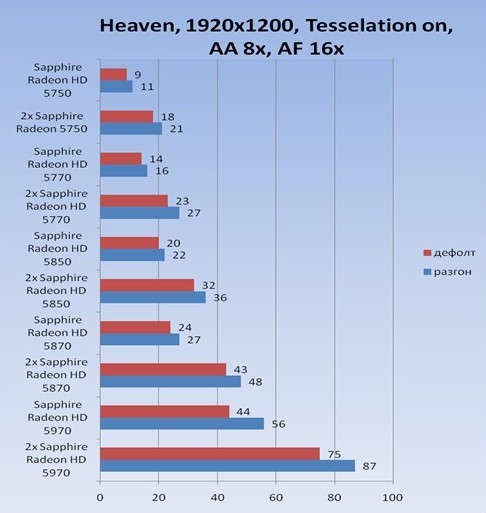
The level of graphics is simply amazing. All this is due to tessellation, turning off which gives a very good increase in fps. Although the top cards have results at a very good level. With the increase in video card power, scalability from overclocking increases.

3DMark 06 is very dependent on the frequency of the processor. With its increase, the growth of results is several times higher than the growth of overclocking the graphics adapter itself. Again, because of this, the results in CrossFire bundles are very weakly exceeding their single comrades.
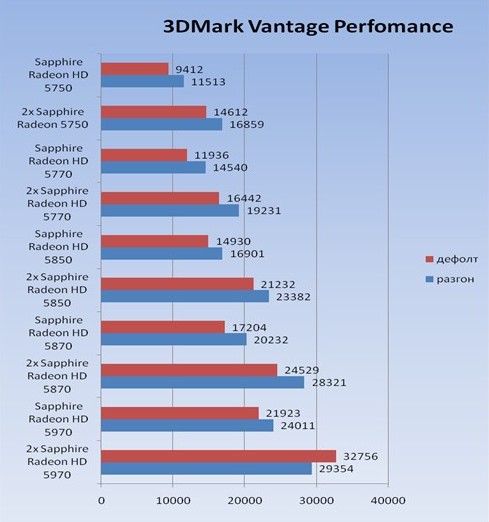
The test, originally designed for Nvidia video cards, now does not cause any difficulties for the new Radeon-s. Dependence on the central processor is decreasing with increasing graphics card power, so the results of top-end cards on overclocking increase very well. There are also no complaints with CrossFire technology - there is a noticeable increase as well.

Crysis, after its release, put on the scapula all existing at the time of the release of the system. A year later, the iron developers were finally able to catch up with the gap laid down by the developers from Crytek. At maximum settings, it will be possible to play the truth only on the top cards, but with a decrease in resolution, even weak cards allow you to play comfortably. Acceleration from overclocking is almost minimal at first glance. But because of the initial low fps in percentage terms, overclocking gives 5-10 percent increase. But from the work of the second video card the increase is much more noticeable.

The continuation of the sensational action came after Crysis, and as we see, the developers of the game in terms of hardware requirements have mercy on us. Starting with the Radeon HD 5770, we can play comfortably even with Full HD resolution. Crossire technology is well optimized in this game, due to the higher frequencies the Radeon HD 5870 pair bypasses the current performance monster Radeon HD 5970.
Conclusions.
The AMD Radeon HD 5xxx family was undoubtedly the most successful during the release of its products. Finally, the developments were able to realize all the power inherent in their GPUs. Sapphire was the first company to enter the Russian market for video cards with these products, and undoubtedly it will get all the cream from sales. And sales at the initial stage show very good results. It is worth highlighting the overclocking potential of sapphire products. For enthusiasts or extreme overclockers, a Sapphire product may be the best choice. Based on the results of our testing, we can award the Sapphire Radeon HD 5850 with the “Smart Choice” Award. Really attractive cost combined with good performance and high overclocking potential make this product the best.

We reward Sapphire Radeon HD 5970 with the title “Our Choice”. The most powerful graphics card of our time - what else can a real gamer dream of!

Testing and text - Vlad slamms Zakharov


Since Sapphire products were the first to appear on the Russian market, we selected products of this brand for testing the line of video cards of the fifth series from AMD.

What and how did we test?
We selected a pair of video cards for each model from the Sapphire HD5xxx family and compared them to each other in 3D benchmarks and games. CrossFire configurations also took part in testing. All video cards were tested at nominal frequencies, and we, OCClub.ru , as a project focused on overclocking, checked the video cards for maximum overclocking.
The list of tested video cards:
* 2x Sapphire HD 5970 (735/1010 MHz)
* 2x Sapphire HD 5870 (850/1200 MHz)
* 2x Sapphire HD 5850 (725/1000 MHz)
* 2x Sapphire HD 5770 (850/1200 MHz)
* 2x Sapphire HD 5750 (700/1150 MHz) The
data of the video card, both in single mode and in CrossFire passed the following tests:
* 3DMark06 - a popular graphics benchmark from Futuremark 2006, showing to this day excellent graphics performance. Default settings.
* 3DMark Vantage - the latest graphics benchmark, originally sharpened for Nvidia. But with the release of HD5xxx, everything has changed. Default settings.
* Heaven - the first DirectX11 benchmark with impressive graphics. Surely, this test will become mandatory in the future set of testers.
* Crysis Warhead - a game that has conquered millions of people around the world. Settings: resolution 1920x1200, graphics quality Very High.
* FarCry2 - a game on the Cry Engine engine with beautiful graphics and an exciting plot. Settings: 1920x1200 resolution, Ultra High quality graphics.

Test bench:
* Intel Core i7 Extreme 975 3.33 GHz @ 4 GHz processor
* Cooler Master V8 cooler
* Asus P6T6WS Revolution motherboard
* 3x 2Gb Kingston 2000 MHz DDR3 CL9 RAM
* Seagate Barracuda 7200.12 500 GB hard drive
* Cooler power supply Master MPower 850W
Sapphire Radeon HD5970 (27,000 rubles)
Test score: 9/10
* number of stream processors - 3200
* number of texture units - 2x 80
* number of ROP blocks - 2x 32
* core frequency - 735 MHz
* memory frequency - 1010 MHz
* memory bus width - 256 bits
* memory capacity - 2x 1024 MB
* TDP level - 294 W

AMD’s top-end two-headed product turned out to be so powerful that the gap in performance from previous-generation video cards turned out to be significantly higher. Honestly, no one expected this level of performance. Hemlock is a dual Cypress, but due to the presence of two cores on the same PCB, the core frequencies are reduced to 725 MHz instead of 850 MHz. Also, with the aim of falling within a certain TDP framework, voltages are also less than usual for Cypress 1.16v. Nevertheless, the fervor of the HD5970 is very hot. Cards from Sapphire were able to overclock to frequencies of 950/1200 MHz, which is a very high indicator. The disadvantages of this card include the high retail price - 27,000 rubles. A bunch of a pair of such video cards can become a utopia in the dreams of avid gamers.
Sapphire Radeon HD5870 (16 000 rubles)
Assessment by test results: 8/10
* number of stream processors - 1600
* number of texture units - 80
* number of ROP blocks - 32
* core frequency - 850 MHz
* memory frequency - 1200 MHz
* memory bus capacity - 256 bits
* memory capacity - 1024 MB
* TDP level - 188 W

The single-chip version of the top class appeared several months earlier on the shelves of Russian stores. Reviews of the card, released on the day of the official announcement, were full of positive moments. The overclocking potential of this card is even better than that of the dual-chip fellow flagship. This is easily explained by the lower temperatures inside the video card itself. Our copies were able to work stably at frequencies of 1000/1200 MHz. The main difference from lower class cards is the presence of a 256 bit memory bus, which allows for higher memory bandwidth. A pair of such monitors bypasses their older "two-headed brother" because of the high core / memory frequencies. But here the total cost against the Radeon HD 5970 will turn out more.
Sapphire Radeon HD5850 (12 500 rubles)
Based on test results: 8/10
* number of stream processors - 1440
* number of texture blocks - 72
* number of ROP blocks - 32
* core frequency - 725 MHz
* memory frequency - 1000 MHz
* memory bus capacity - 256 bits
* memory capacity - 1024 MB
* TDP level - 151 W

The same Cypress, but with low frequencies and high overclocking potential. Cheaper, colder, quieter is a lot of positive moments. Where are the minuses you ask? You won’t believe it, but I didn’t find any cons, the cards easily overcame the nominal level of HD5870 in overclocking and settled at 920/1150 MHz. And this is without raising the voltage on the GPU! There is also good news for those who have a case not the latest model. The video card can be installed in most modern cases without problems, when the HD5870 and HD5970 can have problems installing them in the case. One card is the best purchase, and a pair is doubly the best choice.
Sapphire Radeon HD5770 (6,500 rubles)
Based on test results: 7/10
* number of stream processors - 800
* number of texture units - 40
* number of ROP blocks - 16
* core frequency - 850 MHz
* memory frequency - 1200 MHz
* memory bus width - 128 bits
* memory capacity - 1024 MB
* TDP level - 108 W

Juniper is a graphics core whose main difference from its older counterparts is the presence of only a 128 bit memory bus. For a graphic memory of 1024 MB, about a year ago, a 128 bit memory bus was not enough. Of course, I understand that this is a low-end graphics card, but nevertheless this is what makes the card too weak. The power of the GPU in this case has a large margin of safety. The HD5770 managed to overclock the frequencies of 1,050 / 1,400 MHz. Although all HD5xxx cards use GDDR5 memory chips, the HD5770 manages to overclock the memory the most. A couple of such cards in CrossFire cannot catch up with the Radeon HD 5850 due to the narrow bus.
Sapphire Radeon HD5750 (6,000 rubles)
Based on test results: 5/10
* number of stream processors - 720
* number of texture blocks - 36
* number of ROP blocks - 16
* core frequency - 700 MHz
* memory frequency - 1150 MHz
* memory bus capacity - 128 bits
* memory capacity - 1024/512 MB
* TDP level - 86 W

This is currently the weakest generation card. The cost of this card is on average 6 thousand rubles. What do we get for this money? The performance of this card is naturally minimal in relation to the older brothers, but with the cards of the previous generation and competitors from Nvidia, the HD5750 can compete on an equal footing. Particular attention should be paid to the level of heat generation, which is close to a minimum, and this, taking into account good performance. Buying a second such card is relevant, as the performance gain is almost doubled.
Test results:

The level of graphics is simply amazing. All this is due to tessellation, turning off which gives a very good increase in fps. Although the top cards have results at a very good level. With the increase in video card power, scalability from overclocking increases.

3DMark 06 is very dependent on the frequency of the processor. With its increase, the growth of results is several times higher than the growth of overclocking the graphics adapter itself. Again, because of this, the results in CrossFire bundles are very weakly exceeding their single comrades.

The test, originally designed for Nvidia video cards, now does not cause any difficulties for the new Radeon-s. Dependence on the central processor is decreasing with increasing graphics card power, so the results of top-end cards on overclocking increase very well. There are also no complaints with CrossFire technology - there is a noticeable increase as well.

Crysis, after its release, put on the scapula all existing at the time of the release of the system. A year later, the iron developers were finally able to catch up with the gap laid down by the developers from Crytek. At maximum settings, it will be possible to play the truth only on the top cards, but with a decrease in resolution, even weak cards allow you to play comfortably. Acceleration from overclocking is almost minimal at first glance. But because of the initial low fps in percentage terms, overclocking gives 5-10 percent increase. But from the work of the second video card the increase is much more noticeable.

The continuation of the sensational action came after Crysis, and as we see, the developers of the game in terms of hardware requirements have mercy on us. Starting with the Radeon HD 5770, we can play comfortably even with Full HD resolution. Crossire technology is well optimized in this game, due to the higher frequencies the Radeon HD 5870 pair bypasses the current performance monster Radeon HD 5970.
Conclusions.
The AMD Radeon HD 5xxx family was undoubtedly the most successful during the release of its products. Finally, the developments were able to realize all the power inherent in their GPUs. Sapphire was the first company to enter the Russian market for video cards with these products, and undoubtedly it will get all the cream from sales. And sales at the initial stage show very good results. It is worth highlighting the overclocking potential of sapphire products. For enthusiasts or extreme overclockers, a Sapphire product may be the best choice. Based on the results of our testing, we can award the Sapphire Radeon HD 5850 with the “Smart Choice” Award. Really attractive cost combined with good performance and high overclocking potential make this product the best.

We reward Sapphire Radeon HD 5970 with the title “Our Choice”. The most powerful graphics card of our time - what else can a real gamer dream of!

Testing and text - Vlad slamms Zakharov
